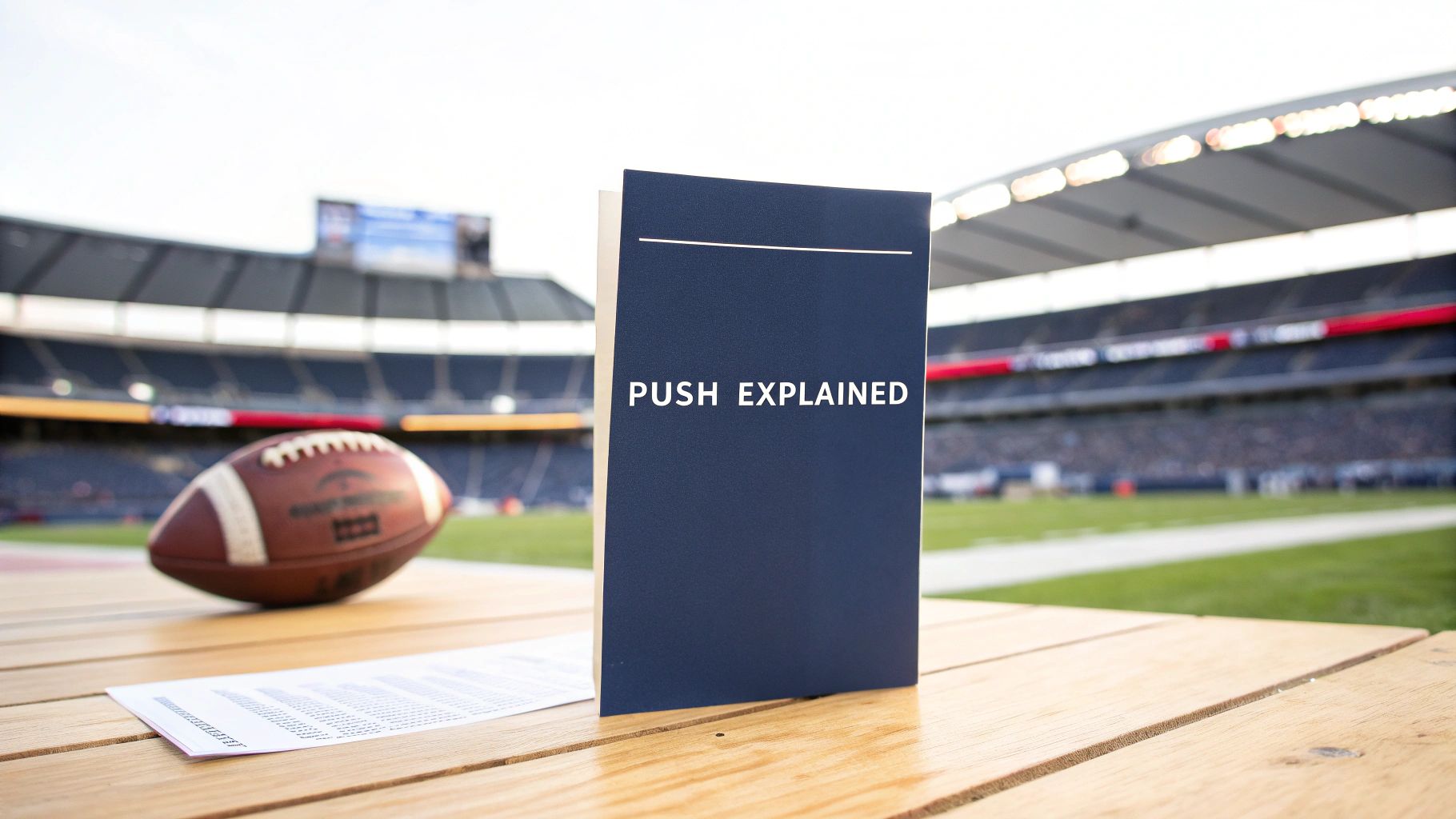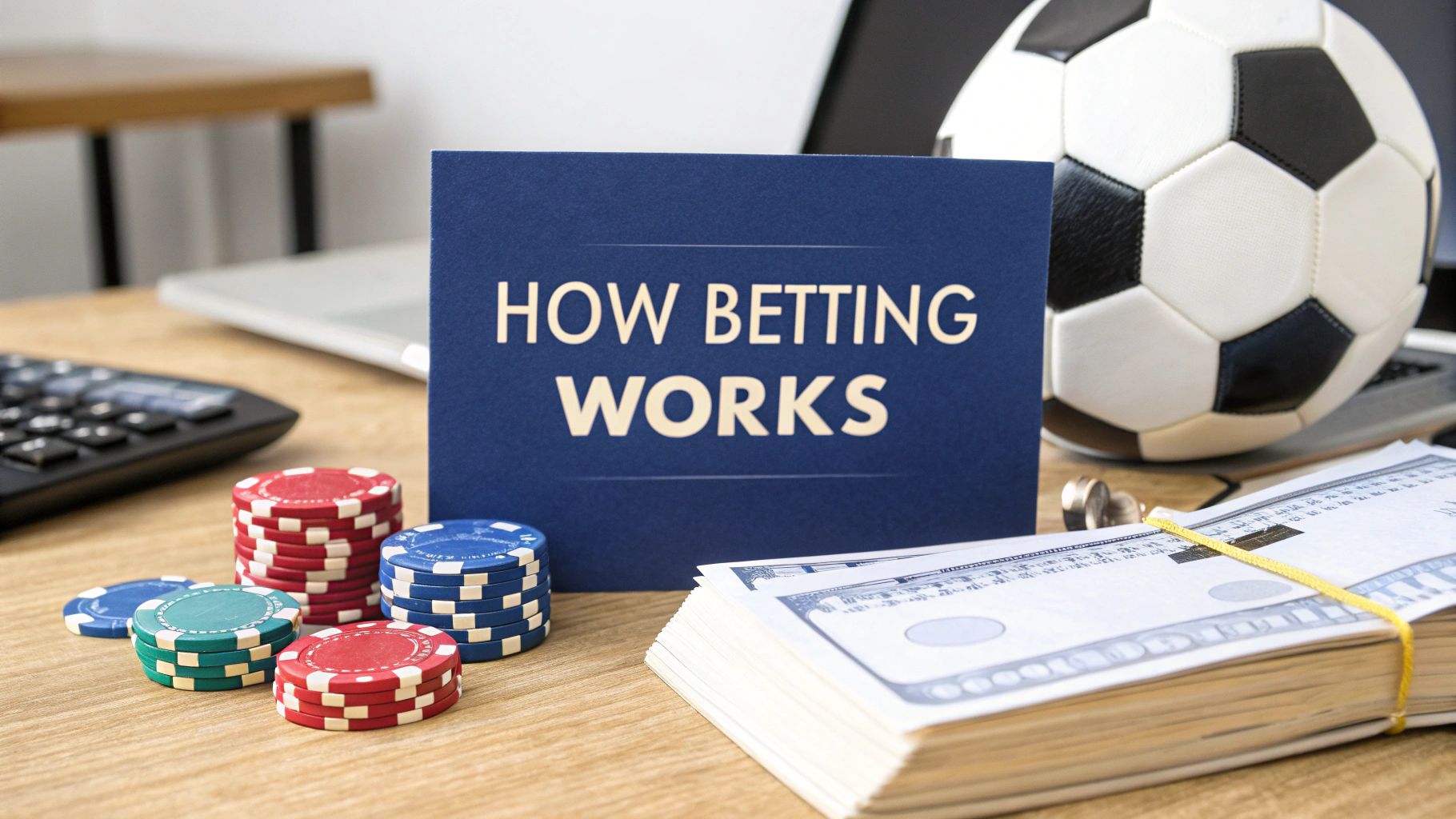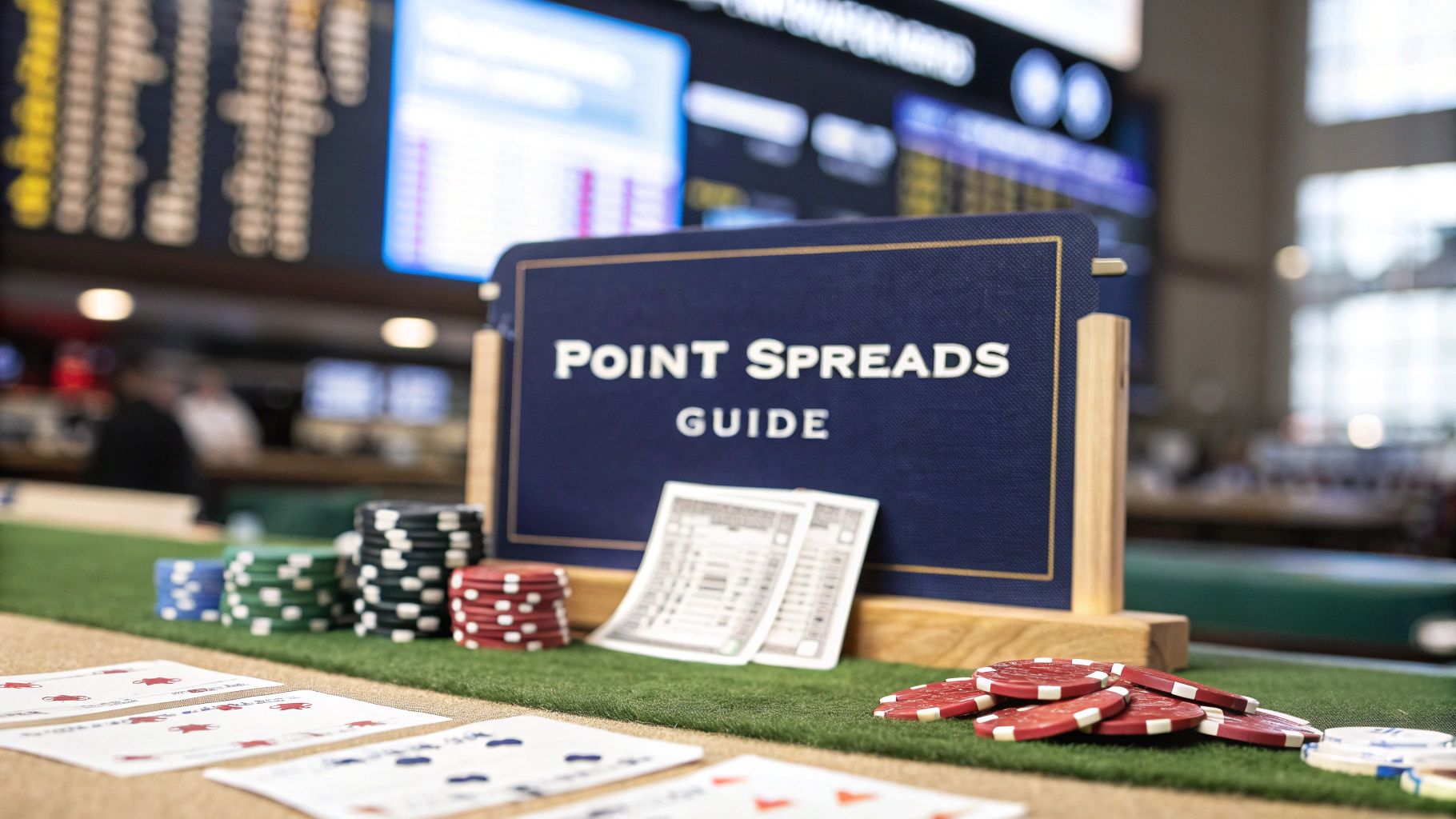
What Does Push Mean in Betting? A Quick Guide
What does push mean in betting? Learn how it happens with spreads and parlays, plus practical tips to navigate this common outcome.
In sports betting, a push is what happens when you and the sportsbook essentially break even. You don’t win, but you don’t lose either. Your original stake just comes right back into your account. Think of it as the game's final score landing perfectly on the betting line, creating a tie.
The Bettor's Guide to a Push
Picture this: you're on the edge of your seat watching a tight game. The final whistle blows, and the score lands exactly on the number the sportsbook set. That’s a push. It’s like hitting a reset button on your bet—the stake is returned, and it's on to the next one.
This is a fundamental concept for anyone betting on sports, particularly here in Romania where it can really shape your strategy. A push can happen in any bet where the outcome matches the betting line perfectly, but you’ll see it most often with point spreads and totals (over/under).
Let's say a football team is favoured to win by 3 points. If they win by exactly 3 points, anyone who bet the spread gets their money back. It's a push. With the huge volume of football and basketball betting happening online in Romania, this outcome is more common than you might think. Getting your head around this helps you manage your bankroll and your expectations. If you're interested in the numbers, you can find more stats on the Romanian online gambling market at xace.io.
A push is your safety net. It’s the betting world’s version of a draw, saving you from a loss on a razor-thin outcome and letting you live to bet another day.
How Pushes Work Across Different Bet Types
So, what exactly does a push mean when you're placing a bet? It's not a one-size-fits-all answer. The way a push works really depends on the type of wager you’ve made—it plays out differently for a point spread compared to a total or a moneyline bet. Let's get into the nitty-gritty of how this 'tie' affects your bets in the most common markets.
You'll bump into pushes most often when you're dabbling in point spread betting. This is especially true for high-scoring games like football and basketball, where the final margins can often land exactly on the numbers set by the sportsbooks.
Pushes in Point Spreads
Let's use a classic football example. Say you've backed the favourite, and the sportsbook has them at -7. The game ends with a final score of 28-21. Your team won, but they won by exactly seven points. This is the perfect recipe for a push.
Because the margin of victory matched the spread perfectly, your bet is a tie. You didn't win, but you didn't lose either. The bookie simply refunds your stake, and you live to bet another day. The same goes if you had bet on the underdog at +7 and they lost by seven—it's still a push.
If you want to get more comfortable with these kinds of wagers, our full guide to understanding point spread bets is a great place to start.
The journey of a bet that ends in a push is pretty straightforward, as this graphic shows.

As you can see, when the final result lands squarely on the betting line, it’s a wash. The bet is graded as a push, and you get your original stake back in full. No harm, no foul.
Pushes in Totals or Over/Under Bets
You'll also find pushes in totals betting, often called an over/under. With these bets, you're not picking a winner; you're wagering on the combined final score of both teams.
Imagine a basketball game where the over/under is set at 220 points. The final buzzer sounds, and the score is 115-105. Add it up, and you get exactly 220.
A push on a totals bet happens when the final combined score hits the sportsbook's line on the nose. In this scenario, both "Over" and "Under" bettors get their money back.
It's a complete neutral outcome for everyone involved. The only surefire way to avoid this stalemate is to bet on a line that includes a half-point, like 220.5. There’s no way for a game to end with half a point, so you're guaranteed a clear winner or loser.
It's important not to confuse a push with a draw. In sports like football, a draw is a possible game outcome. If you place a standard moneyline bet on a team to win and the game ends in a tie, your bet is a loser. A push is something different—it only happens when the result aligns perfectly with the spread or total number.
To make this crystal clear, let's look at how a push can occur across the most popular bet types.
Push Scenarios Across Different Bet Types
| Bet Type | Example Scenario | Outcome | Result for Bettor |
|---|---|---|---|
| Point Spread | You bet on Team A at -3. Team A wins the game 24-21. | Team A won by exactly 3 points, matching the spread. | Push. Your stake is refunded. |
| Totals (Over/Under) | You bet "Over 48" in a game. The final score is 28-20. | The total combined score is exactly 48 points. | Push. Your stake is refunded. |
| Player Props | You bet on a player to score "Over 2.0" touchdowns. He scores 2. | The player's total matches the line exactly. | Push. Your stake is refunded. |
| Moneyline (2-Way) | In a knockout tournament, you bet on Team A to win. The game goes to overtime and Team A wins. | A winner is determined, so no push is possible. | Win. Your bet is paid out. |
This table shows that pushes are all about hitting a specific number, a key reason why sportsbooks often use half-points (-3.5, Over 48.5) to guarantee a decisive result and avoid refunding stakes.
Seeing a Push in Real-World Betting Scenarios

Theory is one thing, but seeing how a rule plays out in a real game is where it all clicks. So, to really get your head around what a push means in betting, let’s walk through a couple of classic examples you’ll definitely run into.
The Point Spread Push
Picture this: It’s Sunday, and there’s a massive football match on. The home side are heavy favourites, so the bookmaker has set the point spread at -7. You feel confident they’ll cover it, so you place your bet, backing them to win by more than a touchdown.
The game is a nail-biter, a real back-and-forth contest. In the end, your team gets the win. The final whistle blows, and the scoreboard shows 28-21.
So, they won, but by exactly seven points. This is the key. Because the final margin matched the spread exactly, the bet can’t be graded as a win or a loss. It’s a tie against the line, and that means it's a push. No harm, no foul—your original stake just pops right back into your account.
The Totals (Over/Under) Push
This same logic applies just as easily to a totals bet, often called an over/under. Let's switch sports to a basketball game. The sportsbook sets the total points line at 220, and you’re expecting a fast-paced shootout, so you take the "Over".
It turns out to be an offensive masterclass, with both teams racking up points. The final score? 115-105.
Time for some quick maths: 115 + 105 = 220.
The combined score landed precisely on the sportsbook’s number. Just like with the point spread, this means every "Over" and every "Under" bet is a push. Everyone gets their money back.
Ultimately, a push is just a draw against the bookmaker's line. It’s a neutral outcome. Of course, some bettors hate the idea of a tie and actively try to avoid it by using different bet types.
That’s where things like Asian Handicaps come in, which often use half-points (like -7.5) to make a push impossible. If you want to dive deeper, check out our guide on what Asian Handicap betting is to see how it works.
How Pushes Impact Your Parlays and Teasers

So, what happens when a push pops up in a more complex bet, like a parlay or a teaser? This is where things get interesting, but don't worry—it’s usually good news. A lot of bettors assume that one pushed leg kills the whole ticket. That's a myth.
Instead of voiding your entire bet, sportsbooks just make a simple adjustment. They essentially erase the pushed leg from the ticket and recalculate your odds and payout based on the selections that are still live.
A Parlay with a Push
Let's walk through a classic scenario. You’ve put together a four-team football parlay that looks like a sure thing. Three of your picks cover the spread with ease, but the fourth team, a -3 favourite, wins by exactly three points. That last leg is a push.
Is your bet a bust? Not at all. The sportsbook simply treats it as if you’d placed a three-team parlay from the very beginning.
- Original Bet: A four-team parlay.
- Result: Three wins and one push.
- New Payout: The odds are recalculated as a winning three-team parlay.
You still get paid, just not the full amount you were hoping for. The risk and reward are simply adjusted to reflect the bets that actually won.
This principle holds true for even more complicated wagers. If you're into building more intricate bets, you can see how this plays out in our guide on what a round robin bet is.
Teasers and Push Scenarios
Teasers, where you get to move the point spread in your favour, handle pushes in a similar way—the voided leg is just removed from the equation.
But there’s a catch you need to be aware of. Some sportsbooks have house rules, especially for two-team teasers. If one leg pushes in a two-team teaser, many will grade the entire bet as a push and just refund your original stake. Always check the fine print.
Pushes are a natural part of the betting ecosystem, acting as a balancing mechanism for both bettors and bookmakers. Industry analysts estimate that around 5-10% of all point spread bets land on the number and result in a push. As mobile betting continues to grow in Romania, understanding exactly how a push can change your payout is more important than ever.
Using Pushes in Your Betting Strategy
Knowing what a push is is one thing, but figuring out how to use it to your advantage is where the real skill comes in. A push isn't just a neutral result; for a sharp bettor, it’s a crucial tool for smart bankroll management.
Think of it as a get-out-of-jail-free card. When a game comes right down to the wire and lands exactly on the number, a push saves you from a loss. Your original stake comes right back to you, ready to be used on the next bet. It’s a do-over, not a defeat.
Pushes and Local Betting Regulations
For anyone betting in Romania, this concept takes on an extra layer of importance because of the local rules. The Romanian National Gambling Office (ONJN) sets the guidelines for all licensed bookmakers, and bettors have to deal with a tax system where winnings are taxed on a sliding scale.
This is where a push becomes a strategic advantage. Since a push means you only get your stake back—no profit, no loss—there's no taxable event. You sidestep a loss without having to worry about any tax implications. In a market expected to pull in US$256 million by 2025, knowing these little details really matters. You can get a deeper dive into the Romanian betting market's regulations and growth on sdlccorp.com.
For Romanian bettors, a push does two key things: it shields your bankroll from a tight loss and keeps that bet off the taxman’s radar. That’s a clear win over taking an L.
At the end of the day, if you start seeing pushes as a form of risk management, you’ll make better choices. The confidence that a close call won’t wipe out your stake lets you be a bit more assertive on tight lines. It turns a simple tie into a smart play in your overall strategy.
Right, so you've got the basics of what a push is, but let's be honest, that's when the real questions start popping up. It's one thing to know the definition, and another to see how it plays out with your own money on the line.
Let's tackle some of the most common head-scratchers bettors run into.
Does a Push Count as a Win or a Loss?
Neither. Simple as that. A push is the betting equivalent of a mulligan – it's a do-over. The sportsbook considers it "no action," which means the bet is voided.
Think of it as a tie against the sportsbook's line. It doesn't ding your win-loss record, and more importantly, you get your original stake back, every penny. It’s like the bet never even happened.
How Can I Avoid Getting a Push on My Bet?
Ah, the million-dollar question. If you hate the idea of a bet ending in a tie, there's a simple trick: always look for lines with a half-point. In betting circles, this is sometimes called "buying the hook."
For example, instead of betting a team at -3, you take them at -2.5. Or, if you're looking at a game total of 48, you bet on Over/Under 48.5. It's impossible for a team to score half a point, so these bets force a definitive win or loss. No more ties, no more pushes.
Key Takeaway: If you want a clear-cut result every single time, half-points are your best friend. They completely eliminate the possibility of a push and guarantee your bet will have a final outcome.
What Happens If a Game in My Parlay Is Cancelled?
This is a common worry, but the answer is usually good news. When a game in your parlay gets cancelled or postponed, sportsbooks treat that leg of the bet as a push.
Your parlay isn't busted! The cancelled leg is simply removed, and the odds are recalculated based on the remaining games. So, if you placed a four-team parlay and one game gets rained out, you're now holding a live three-team parlay. It just gets a little smaller, but it's still very much in play.
Is a Push the Same as a Draw on a Moneyline Bet?
Absolutely not, and this is a critical difference that trips up a lot of new bettors, especially in football.
Many football matches offer a "three-way moneyline", where you can bet on Team A to win, Team B to win, or a Draw. If you bet on Team A to win but the game ends in a tie, you've lost your bet. A push can only happen when the final score lands exactly on a point spread or a totals line, not on a moneyline bet that includes the draw as a third option.
Ready to turn betting theory into confident action? OddsHaven uses powerful AI to analyse thousands of data points, delivering daily high-confidence football picks and parlay suggestions. Find your edge today at OddsHaven.
Ready to Start Winning?
Join OddsHaven and get instant access to AI-powered predictions with an 87% win rate on high-confidence picks
Try OddsHaven Free for 5 Days

